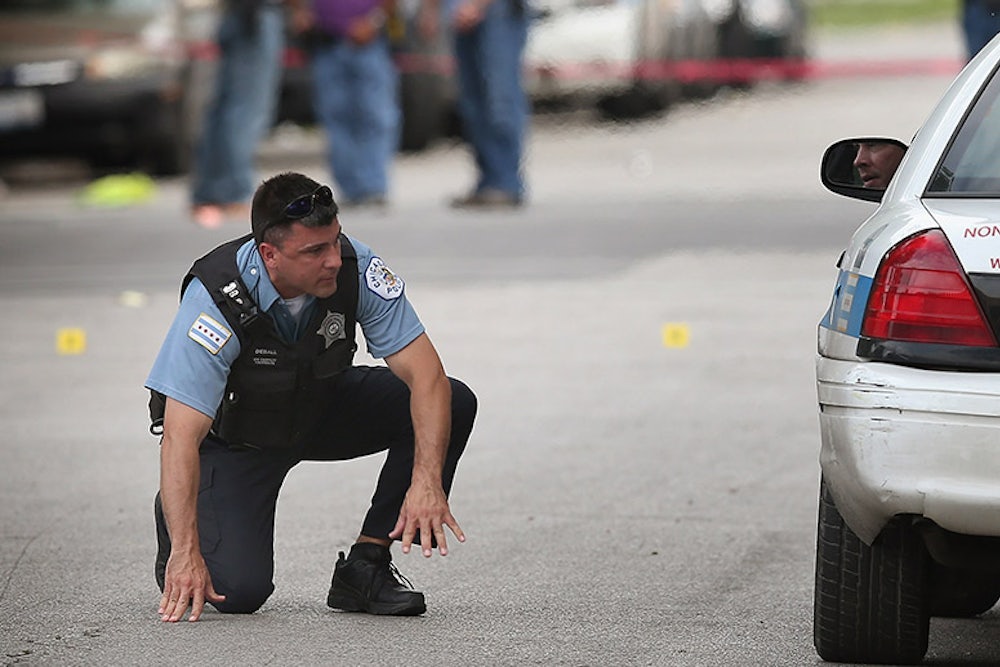Someone was shot near my apartment in Chicago recently. Then someone else was shot a few blocks away, near the movie theater where I saw Nebraska. You might not think that's news: Lots of people are shot in Chicago. But not in Logan Square, the rapidly gentrifying neighborhood where I live, and so the shootings were the subject of anxious chatter for a while.
Despite living in a city where homicides are so common that they've attracted international media attention, my neighbors and I expect them to intrude on our sense of personal safety about as much as if we lived in, say, Seattle. Coverage of Chicago's lethal crime tends to downplay, or leave out entirely, the fact that the number of homicides here has plummeted since the early 1990s, from a rate of over 30 per 100,000 residents to about 15.


But Chicago's crime was never distributed evenly across the city, and the decline hasn't been, either. In and around downtown, and on the North Side, neighborhoods with moderate numbers of homicides became some of the safest urban areas in the country. A million people in Chicago, the global poster child for first-world urban violence, now live in neighborhoods that together have the same homicide rate as New York City, the “safest big city in America.”
Meanwhile, much of the rest of Chicago has seen much more modest declines, or stagnation. In the case of two police districts on the South Side, the homicide problem has actually gotten worse. In the early 1990s, the most dangerous third of the city saw about six times more murders than the safest third. Over the last several years, the most dangerous third has seen between twelve and 16 times more homicides.

Given the increase in economic inequality over the last two decades—and the relationship between a neighborhood's wealth and its crime rate—maybe it’s not surprising that the inequality of crime has been growing as well. But New York and Los Angeles, which along with Chicago are among the ten most unequal cities in the country, haven't seen anything like that kind of change.


In New York, where crime has fallen farther than nearly anywhere else in the country, the drop has been almost even across precincts: 87 percent in the most dangerous third of police precincts, and 85 percent in the safest. Los Angeles has been somewhere in between, with the ratio of homicides in the most dangerous third of the city to the safest growing from about four in 1998 to about seven by 2011.

The disparity in crime rates complicates public debates about where to deploy scarce police resources. A popular blog about crime in Lakeview, an affluent neighborhood where the homicide rate averages about one per 100,000 residents, complains of an “epidemic” of muggings and blames City Hall for putting too many cops on the streets of South Side neighborhoods where the murder rate is over 40 times worse. It also puts much of the South Side—already reeling from nearly a century of deprivation of public resources, wildly exploitative housing markets, and deindustrialization—at an even greater disadvantage in attracting and keeping businesses and middle-class households.
As those neighborhoods' crime rates become ever more extreme compared to the rest of the city's, people who can leave are increasingly doing so. Chicago lost 200,000 people during the 2000s, a large proportion of whom were members of the black middle class who fled to the suburbs or other cities. Earlier this year, when a large local grocery chain went out of business, all 15 of its city stores were quickly bought up by other chains—except for the one in South Shore, an attractive neighborhood on Lake Michigan with a large middle-class presence that happens to have one of the highest violent crime rates in the city.
Housing prices have conspired to make it much harder to live in safer neighborhoods for people with modest incomes. Data from a national study of income segregation by researchers Sean Reardon and Kendra Bischoff show that a huge and growing swath of the North Side, as well as the safer pockets of the far South Side, are now mostly populated by families with incomes far above the city's average.
It's hard to argue that anyone ought to lower their expectations about safety for themselves and their family. But it's also impossible to argue that it's healthy, or fair, for a fraction of the city's population to bear such an overwhelming burden—and that's where the city finds itself today.
